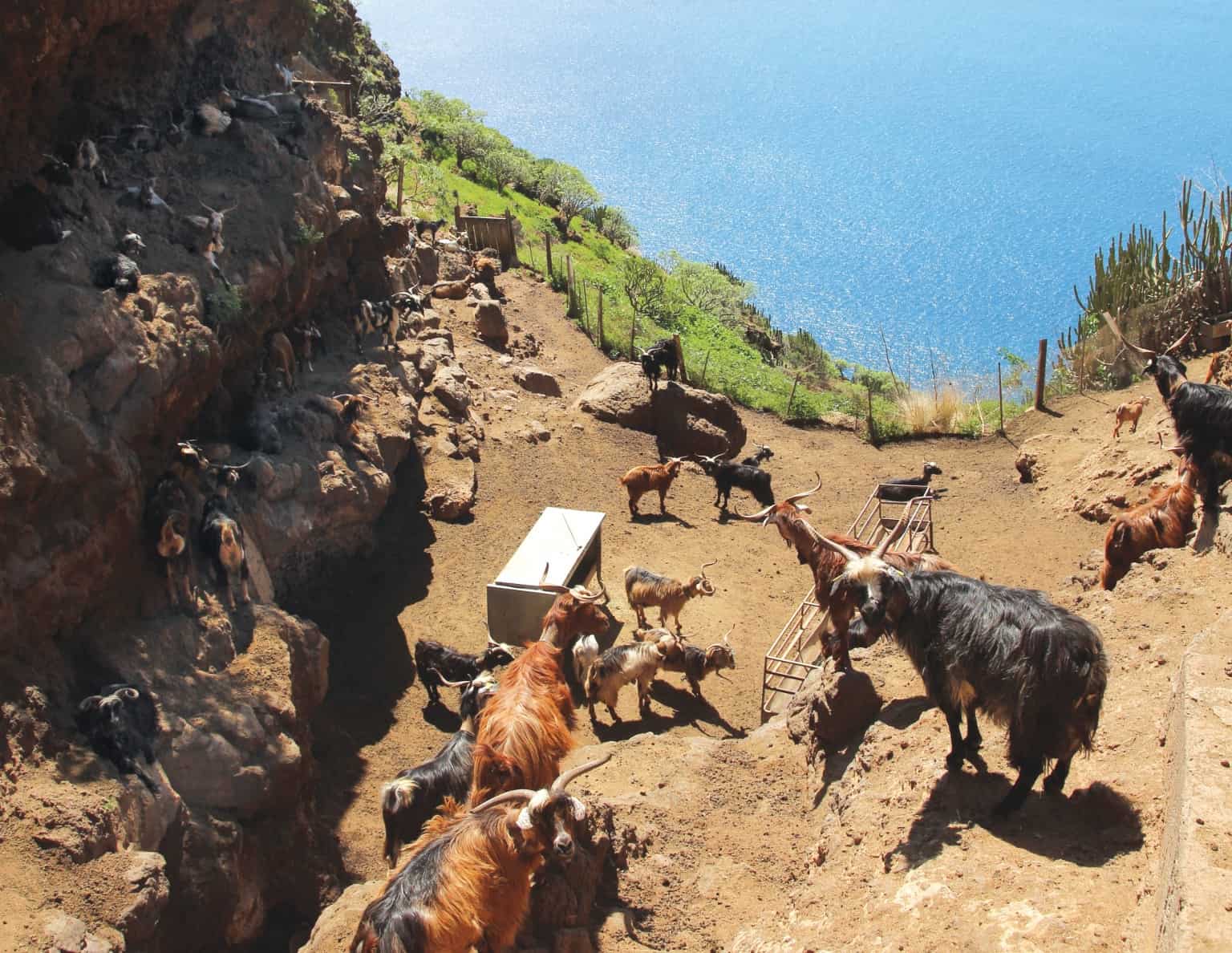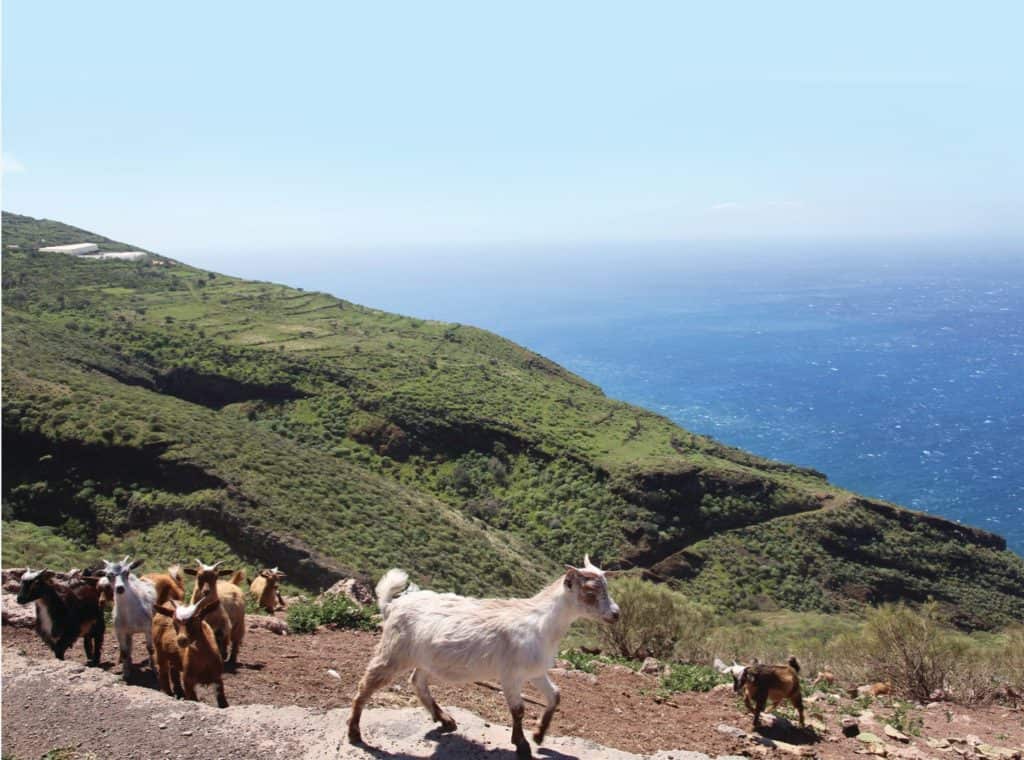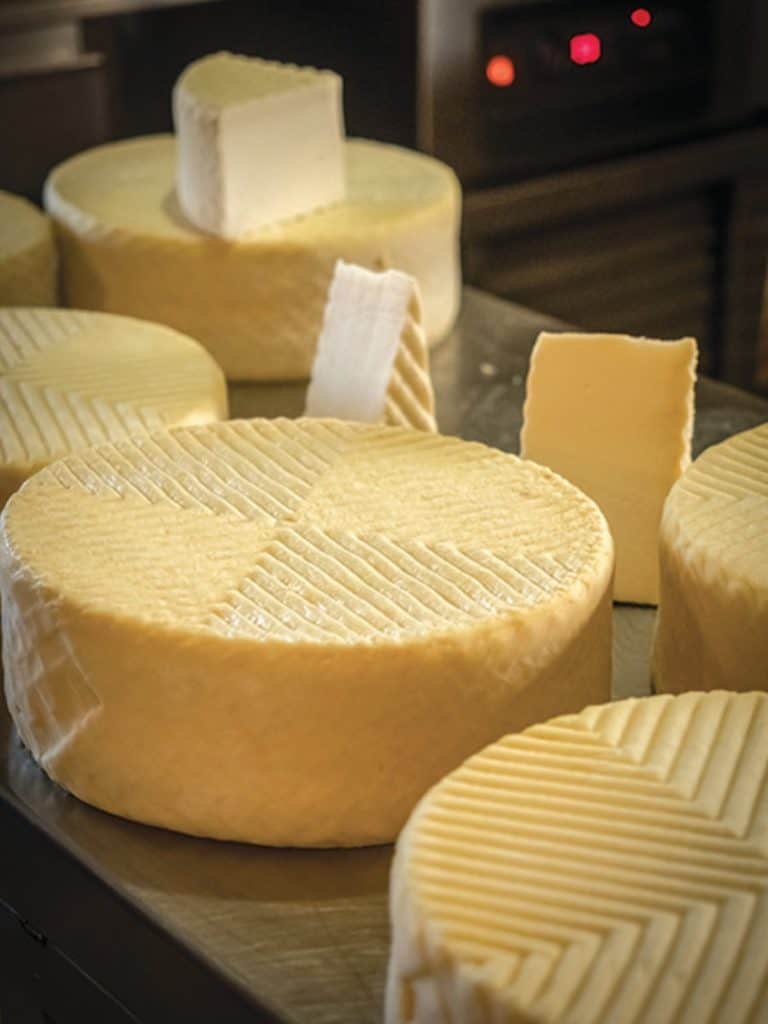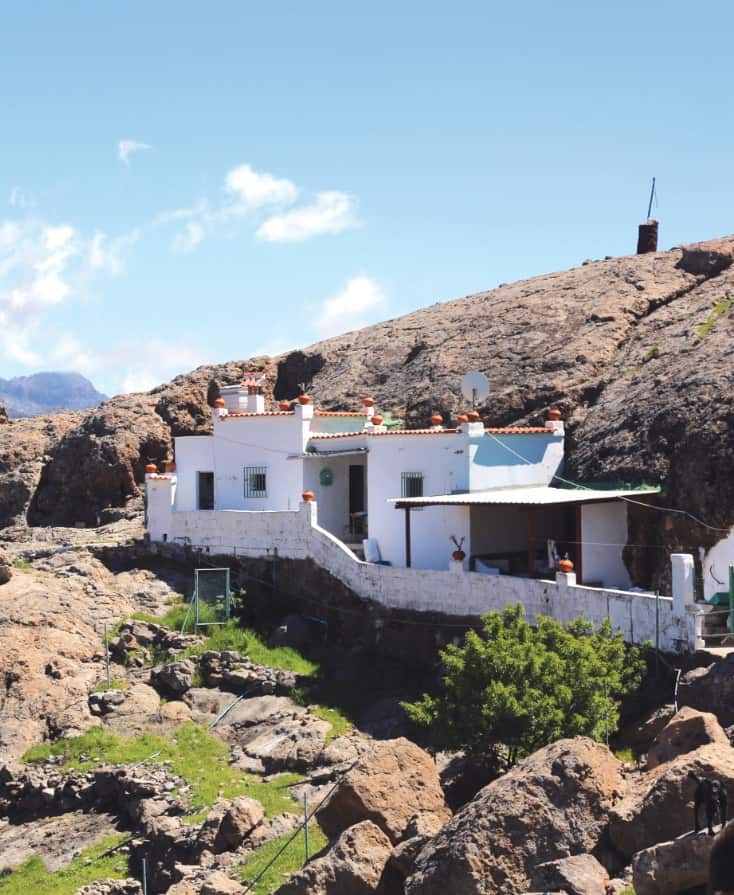
Now, we are passing between two worlds,” announces Canarian cheese expert Isidoro Jiménez as we leave the beach town of Maspalomas behind. The image of sun-drenched boulevards speckled with meandering tourists shrinks in the rear-view mirror of our 4×4; suddenly, the landscape is void—nothing but shrubs, cacti, and a dirt road that twists and turns beneath a blue sky.
When I notice the traces of crumbling terraces in the hillsides, Jiménez explains that the landscape around us was once very different. It was all farmland—here, it was full of tomatoes—until the economy of the Canary Islands changed in the mid-20th century. On the island of Gran Canaria, as in much of the Spanish archipelago, tourist resorts began to spring up on the coasts. Residents flocked to the seaside looking for work. “Many people abandoned agriculture, abandoned the countryside,” Jiménez says.
These islands yield countless surprises—majestic goats with fabulous toupees, houses carved into volcanic craters, and exotic wheels of cheese I’ve never seen the likes of anywhere else.

It’s no surprise that the Canary Islands’ coasts became a tourist magnet. Perched 600 miles southwest of Spain in the Atlantic Ocean, these volcanic landmasses—67 miles off Morocco at their easternmost point—offer a reliably mild and sunny climate even when mainland Europe is dreary and cold. The sandy beaches and red-gold hills of the eastern islands recall the Sahara desert; travel west, and the islands become greener, their terraces overflowing with bananas, avocados, mangos, and coffee. When I visit in mid-March, bone-chilled and vitamin D–deficient from the New England winter, I feel a primal urge to lie in the sand and eat bananas.
But that’s not why I’m here. I came to find out what’s still lingering in the hills and hiding in the caves—what Jiménez describes as the Canary Islands’ “other world.” With just a slight detour off the beaten path, these islands yield countless surprises—majestic goats with fabulous toupees, houses carved into volcanic craters, and exotic wheels of cheese I’ve never seen the likes of anywhere else.
Melting Pot
Away from the beach towns, ruminants rule the hills. “Shepherding is the oldest way of life here,” says Rafa Molina, a Gran Canarian who offers guided hikes and excursions with his tour company, Etno Experience Canarias.
For thousands of years, communities of indigenous people known as the Guanches inhabited the archipelago, herding goats and sheep for meat and milk. While they likely shared roots with North African Berbers, the Guanches’ origins remain largely a mystery; after Spanish conquistadores arrived in the late 15th century, their language and culture quickly disappeared. But hints of their legacy linger in the maze-like petroglyphs etched into seaside boulders, in unfamiliar words and place-names, and in culinary traditions.

Queso Majorero PDO (Photo courtesy of aaabbbccc/shutterstock.com)
The Spanish conquest of the Canaries coincided with that of the Americas, and the islands quickly became the jumping-off point for European explorers, including Christopher Columbus; it served as a final place to stock up on fresh water and food before crossing the Atlantic. Colonies that sprung up in the New World precipitated a growing demand for cheese, and soon ships were departing Canarian ports filled with firm, aged wheels that could survive the journey.
In the Canarian highlands, new settlers from Spain and elsewhere in Europe took up shepherding and cheesemaking to meet the demand, cultivating local ruminant breeds and drawing from a mix of dairy traditions. Their cheeses were a mélange, Jiménez says: “They integrated elements from other places, intertwining techniques.” And they mirrored the multifaceted cuisine of the archipelago as a whole: “Even though we are so small and isolated, we have always had contact with people from all over the world,” Molina says.
On first glance, Canarian wheels strike me as echoing Spanish tradition, but a closer look reveals unique traits. On the island of Fuerteventura, for example, makers of goat’s milk Queso Majorero often coat the outside of wheels with gofio, a milled flour made from toasted grains that was a dietary staple of the native Guanches. On Gran Canaria, wheels of mixed-milk Flor de Guía are rendered soft and oozing from the milk’s coagulation via thistle flower, a practice common in Portugal. Cheesemaking is also shaped by the vast range of endemic flora: On La Palma, goat’s milk Queso Palmero is sometimes smoked using native Canarian pine needles, almond shells, or the dried vascular structure of the prickly pear.

José Mendoza Mendoza and his daughter Belén manually press wheels of sheep’s milk cheese.
Etched in Stone
Despite a changing economy in recent decades, many unique dairy traditions persist—and not long after leaving Gran Canaria’s coast, we turn off the main road in search of them. We skirt across a plateau, past fluffy sheep grazing on early spring grass, toward an odd white structure that protrudes from a rock.
It has the façade of a house, but when we step through the door, we’re in a cave. Surrounded by craggy walls, a family of five bends over wheels of fresh sheep’s milk curds, massaging and pressing them into molds atop traditional wooden tables called queseras, carved with Canarian motifs. Patriarch José Mendoza Mendoza digs in with his fists, while his daughter, Belén, leans into a second wheel using her knees, Nike sneakers splayed out behind her.
The Mendozas are among 20 remaining families on Gran Canaria who live as nomads, following the way of life that sustained local cheesemakers for centuries. They move their animals with the seasons, sleeping in cave-houses like this one—traditional structures that utilize the island’s porous volcanic geology. In late winter and early spring, they’re here on a sunny south-central plateau; in summer, they’ll move their 300 sheep toward the summits of the island’s center; in fall, they’ll return to their home base in the lush, humid north; and in early winter, they’ll head toward the west coast.

The Mendoza family’s cave house in the Gran Canarian highlands
It might seem excessive to move constantly on a landmass that spans just 30 miles—but despite their sizes, each of the Canary Islands is a self-contained world. “We call Gran Canaria a miniature continent because there are such different landscapes,” says Mary Fe de León, gastronomy expert at the Gran Canarian office of tourism. “We have five different microclimates. There might be snow up at the top of the mountain one day, but in one hour’s drive you can be at the beach, and it’s hot.”
It’s all about topography. These aren’t just islands—they’re also giant mountain ranges, volcanoes that shoot up steeply from the sea floor. The rocky peaks that form their ubiquitous calderas, or craters, form natural barriers for the cool, humid trade winds that blow from the Atlantic. As a result, northern coasts are green and foggy, while cacti and shrubs speckle the sunny south. Temperatures plunge as you head toward the central highlands, and inside volcanic craters you can find thick forests full of ancient laurels.
Head for the Hills
Nowhere is the landscape more dramatic than on La Palma, a teardrop-shaped western island that’s considered the steepest in the world. As I bounce around the passenger seat of a truck alongside Alejandro Escuder, a veterinarian who works with cheesemakers on the island, I discover what that superlative feels like: a road of endless switchbacks that never stops winding and a constant feeling of teetering above a vast, sparkling blue ocean.
The stark slopes leave little space for sprawling farms; instead, cheesemaking operations on La Palma are attached to family houses, wedged between tiny milking parlors and aging rooms with windows positioned to catch whiffs of sea breeze. Usually, a small cheese-smoking oven sits adjacent to the aging area, with piles of almond shells or dried cacti foraged from the surrounding hills, ready to be burned. “These are mini queserias,” says Escuder, as we set out to visit farms and collect cheese samples for the Queso Palmero PDO organization, his employer. “They are local cheeses made by families—a husband and wife, a mother and son, or brothers.”

José Carlos Pérez Loreno presses a large wheel of Queso Palmero in his cheesemaking room.
It’s clear as we descend a dirt road toward Quesos El Mocán, a cheesemaking operation owned by twin brothers José and José Carlos Pérez Lorenzo. The tiny structure is tucked into the base of a ravine that plunges straight into the Atlantic Ocean. Outside, agile Palmera goats—the island’s native breed, built to efficiently scale rocky ledges—lounge in the nooks and crannies of the surrounding cliffs. Inside, José Carlos takes a break from hand-pressing the morning’s curds to stir the afternoon milk in a plastic tub. Vats are a rarity in these small operations, where fresh milk, still warm from the goat, is transformed without any heating. José Carlos, who learned shepherding from his father and managed his first herd at the age of 16, manipulates curd with years of accumulated instinct.
“In La Palma, this is our history. Our life is goats,” Escuder explains, describing the local shepherds, some of whom live to be nearly 80 years old yet refuse to give up herding. “If these people stopped having goats, they would be bored and sad—it would not be good,” he says.
As younger generations are drawn toward coastal and mainland cities, it’s more important than ever that new farmers carry on shepherding traditions and maintain the rural Canarian landscape. That’s why PDO cheese organizations like that of Queso Palmero offer help to budding makers and work to promote the cheese. Escuder is optimistic. “Young people are looking for farms, too, and I try to help them,” he says.
Visitors Welcome
Back on Gran Canaria, Molina echoes the sentiment. “We need young people,” he says. On the tours he provides to local schools, Molina often visits Tania Rivero and Francisco Javier González, 29- and 32-year-old shepherds who are turning out award-winning sheep’s milk cheeses at Cortijo de Galeote. It’s an effort to show a new generation that that continuing Canarian tradition is a valid life choice.
By offering foreign visitors a chance to stray off the beaten path, traveling by Jeep or by foot into the highlands to visit shepherds and artisans, Molina is also setting the standard for an alternative type of tourism that bolsters local culture. After all, not everybody wants to lounge at a coastal resort. My beach-bum instincts vanished once I realized the Canaries offer so much more: tiny villages in the mountains, breathtaking hiking trails, cycling tours, wine tasting at vineyards, exploring ancient cave houses, and—of course—ogling goats.

Queso Palmero PDO
As for the cheeses themselves, Canarian wheels have been generating quite a buzz on the world scene. At the 2008 World Cheese Awards, Queso Arico Curado Pimentón—a goat’s milk wheel from the island of Tenerife rubbed with red pepper and gofio—was named the single best cheese in the world. In 2009, one out of every 10 cheeses winning a World Cheese Award hailed from the Canary Islands. In 2017, the tiny archipelago laid claim to four Super Gold medals, the most distinguished category.
“If you want to try the cheeses, you’ll have to come here.”
Nevertheless, with a few exceptions, you’ll have trouble finding these cheeses stateside—or even outside of the islands. That’s due in part to a tight supply; residents of the Canaries boast the highest annual per-capita cheese consumption in Spain—14 to 16 kilos per person, almost double the national average. “We love cheese,” says Rafael Dominguez, export manager at cheese distributor Chacón e Hijo on the island of Tenerife. “We eat most of what we produce ourselves.” And nearly all of it is made on tiny family farms. “The production is so small, so it’s not really the goal to export,” says Fe de León. “If you want to try the cheeses, you’ll have to come here.” It’s the perfect excuse to discover the world of wonder these islands have to offer.
Photography by Molly McDonough



